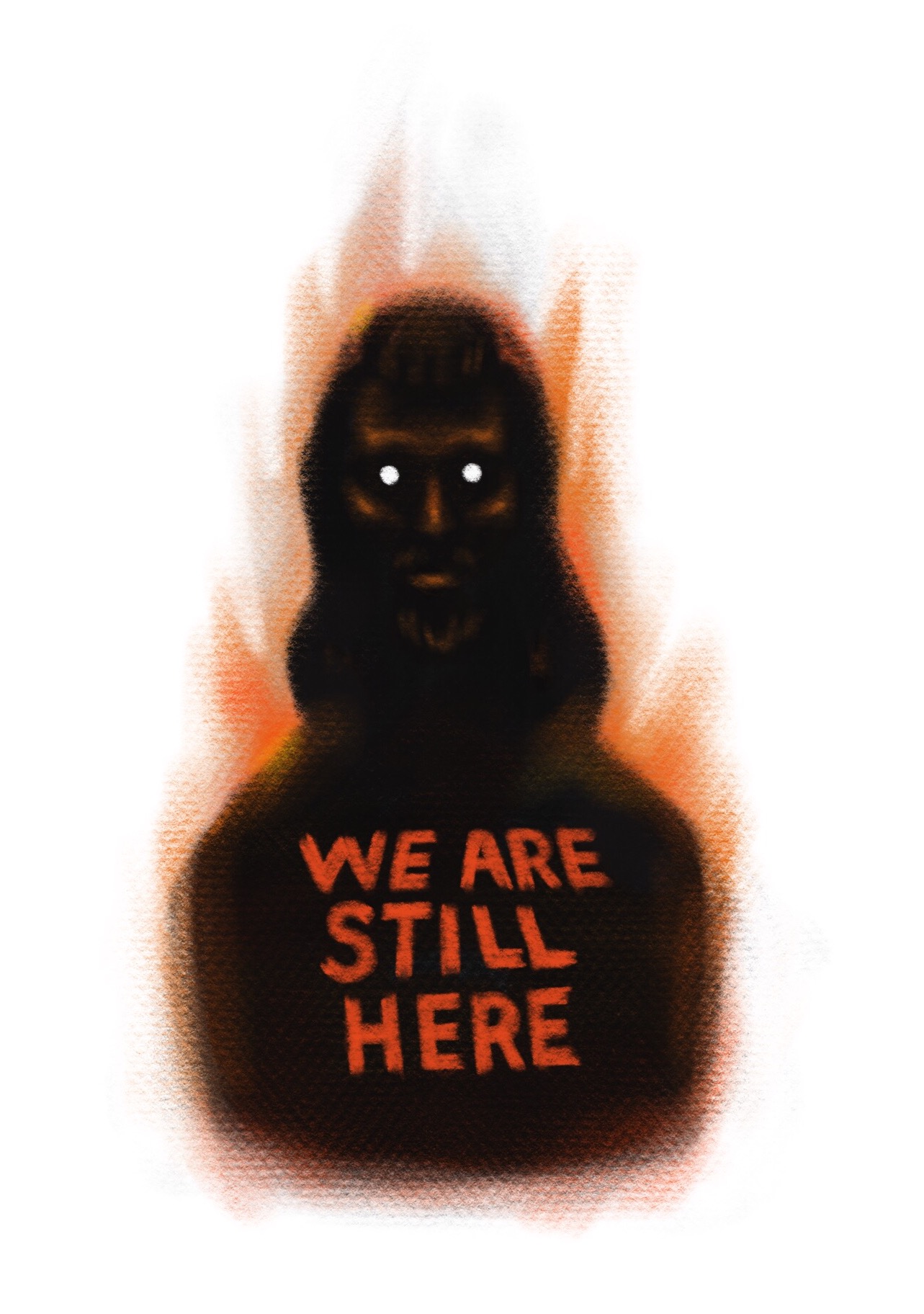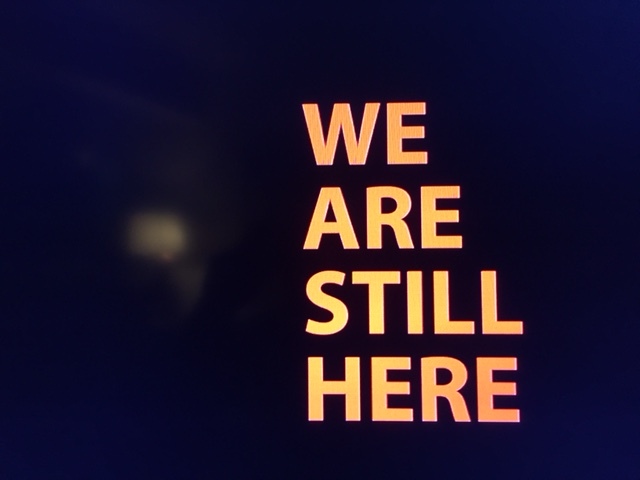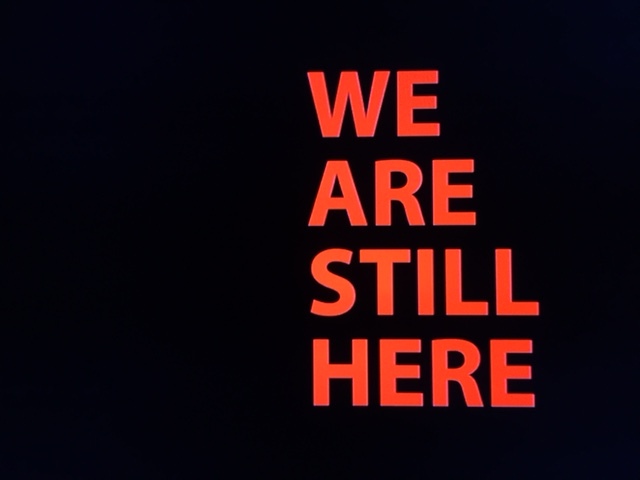October Diaries: We Are Still Here
 Â
Illustration by Max Brown
Blurbs by Jesse, Sean & Christof
Â
Illustration by Max Brown
Blurbs by Jesse, Sean & Christof—
October 2nd, 2016:
We Are Still Here
Year: 2015
Director: Ted Geoghegan
Format: Streaming
From IMDB:Â In the cold, wintery fields of New England, a lonely old house wakes up every thirty years – and demands a sacrifice.
Tagline:Â This House Needs A Family.
Jesse’s Take:
What I liked:
This movie had two things going for it, fire demons that they showed you right quick and didn’t dick around with their reveal and some dope well lit snowscapey shots. Pretend that the white background in Max’s wonderful drawing is snow, and you have 100% of what I liked about this movie in one simple image.
What I didn’t like:
Everything was poorly executed here and literally nothing worked together correctly. The cast was largely unknown, but also completely unlikeable. So take away points for casting and performances Though I guess it doesn’t really matter because the story was often times incoherent, so maybe I didn’t care about anyone because of that fact. For a movie that seemed to get off on explaining things to you in a heavy-handed manner, it failed to explain two things that I found to be important. First I had no idea the bonkers ass rules of this crazy snowy fire demon house, and second, they make a big to do about their son, and it felt to me like there was more to his story than we got. And finally, a 100% completely unforgettable score, if you wanna crank up the creepy, you gotta try and give us a cool score to remember everything with.
Final thoughts:
A movie for the critics, but not for the fans. Do yourself a favor and rush out to never see this movie. Unless you like shitty incoherent muddling non-scary horror movies, then you might wanna give this one an hour and a half of your time, which reminds me  this movie felt like it was at least 2 hours and 23 mins long.

Sean’s Take:
What I liked:
The char-creepy design of the supernatural terror element was pretty cool. These basement creepers, seeming to be made entirely of BBQ charcoals, deserved a better mythology to cling to but they were interesting (if hollow) whenever on screen.
I loved the mythic hole-in-the-wall in the basement which got ample screen-time. When it sprayed-up blood the film peaked.
Also, a multi-knife jab to a throat was particularly well executed (pun whatever).
What I didn’t like:
The script abandoned the actors on the first page and left them treading turgid narrative until the end. It felt composed of several “and then maybe this happens†moments without seeming to respect the “nah, we can’t do that ‘cus it wouldn’t make sense here†moments which should’ve quickly followed the initial thoughts.
Barbara Crampton was wasted (all the characters drank enough whiskey to be constantly wasted) but her presence as an actor was very wasted. She, a true legend of the Stuart Gordon realm, especially deserved better.
Final thoughts:
I can already tell I won’t remember much of this one by the end of the month.
Rotten Tomatoes scores can be especially meaningless when it comes to what I enjoy in the horror genre (this one had a 95%!!!).

Christof’s Take:
What I Liked:
Welcome to the bottom of the barrel!
I liked two things about this movie.Â
A possessed man, who had been tied to a chair and gagged with balled-up socks, swallowed the socks, creating a creepy bulge in his throat. That was swell!
And there was a moment where Barbara Crampton’s character used three or more knives in the same hand to stab someone in the throat. Neato!Â
What I Didn’t Like:
Almost everything else.
The primary hindrance is the writing. The acting didn’t help any, but it is not an easy task to act out a terrible screenplay and make it work, so let’s focus on the root problem. In theory, our primary characters are grieving the loss of their son — which is the supposed motivation for moving into a new house — but their actions and dispositions don’t speak to this grief, only their expository dialogue does.
While we’re on the topic, the dialogue deals in the most boring colloquial phrases, such as:
“You don’t have to ask me twice.â€
“Hey, what are friends for?â€
“This oughta take the edge off.â€
And so on. This is the calling card of a writer who should never be called. It is the lazy technique of writers so inexperienced or hack that they refuse to develop characters, much like children refusing to eat vegetables. Instead, they think they can trick an audience (or at the very least, trick themselves) into becoming invested in flat characterization by using mundane clichés, because of their recognizability. I assume the rationale goes something like this: Hey, people say these things! These are the things people say! Therefor, my characters is like people! I did good job! I deserve eat cookie now!
Such cringe-inducing blemishes aside, the writer-director is addicted to exposition. When the dialogue isn’t completely useless, it is distractingly “useful†in its heavy hints and backstory binges. This happens throughout. (During the credits, there are images of newspaper clippings pertaining to the backstory of the town and cursed house, and I thought, I know what they’re going for here, but fuck, they’re still feeding us exposition!)
There is even a scene that opens with our lead characters telling the story of being told a story by their neighbors. It’s maybe 20-40 seconds of utter uselessness, but it’s the sort of thing that can and should be cut, if not by the writer/director, then certainly by the movie’s editor. (Just start the scene with the friends’ reaction to the story, please.)
Moving on to a different mess: we are introduced to two younger side characters who are simply there to be killed off moments later, which is not unheard of — a bad movie will often do this just to keep a blood-thirsty audience from turning it off. But this specific example of the slothful convention is one of the most obnoxious I’ve seen. These are characters that have been invited to the house and are expected to be staying at the house. When they arrive, the others are out, with a note on the door expressing as much. So these younger “characters†go in, pour some drinks, start fooling around, hear a noise, and decide to check it out. One of them is killed in the basement, and the other is killed in the car while driving away from the terror. (The ghost decided to hide in the backseat for a few miles, I guess?)
To recap, the writer/director took special measures and made logical reaches to make sure these characters’ bodies would not be found by our main characters. When everyone gets back to the house they assume these characters just didn’t show up! Maybe they decided not to come! Or maybe they’re coming later! But here’s the thing: it serves nothing to have our characters remain oblivious.
This is the seed that is planted but not harvested. The gun that never goes off. The writer didn’t seem to see the point in bothering our main characters just yet. Why have them think something is wrong? Why harsh their mellow? Why remotely justify the inclusion of cheap, quick kills? Why utilize an instance of having your characters actually discover something so that both the information revealed and its corresponding dread would be earned?
The sequence is a piece of malfunctioning dramatic irony, and I can’t tell you how much I hate it.
(I spent much of the movie taking snippy notes, so I might be wrong about this next bit, but I think a few scenes later, the character who becomes possessed does reveal the death of the aforementioned non-characters, but by this point, we are already in the thick of it, tension-wise, so its contribution to the dread is minor where it could have been major. Maybe the writer is so concerned with telling instead of showing that simply slipping this tidbit into a demonic monologue was the only way that made sense to him.)
The biggest problem with the movie is that the writer-director seems to love ghost stories and haunted house movies, but has no understanding of how they work. He never learned how to observe salient elements of craft, so he cannot deconstruct them, which means he cannot construct them into something of worth. He has taken a handful of the things he liked about other movies and put them in a salad spinner.
The most glaring and offensive aspect of this ties back into the expository pulse of the story. A ghost story is usually only intriguing if 1) the characters are interesting, and/or 2) the characters are concerned with solving the mystery that lurks behind the walls and under the floorboards of their apparitional abode.
In We Are Still Here, the characters sit back with glasses of scotch and simply allow the mystery solve itself in front of them.
Final Thoughts:
This is a movie that could almost pass as mediocre, as it had some well-designed flourishes of CGI as well as a cinematographer who didn’t succumb to complete creative apathy after reading the screenplay. But don’t let the paint job fool you. The engine is bunk, and the transmission is full of sawdust.
This motion picture doesn’t deserve to be honored with the word “mediocreâ€. It is bad.
And if you’re a horror fan, don’t let that excite you either. It’s not bad enough to be good. I may be a bitter snob sometimes, but I often assert my haughty verbiage in defense of what many would call irredeemable trash. The difference between a bad movie and a movie that is “so bad it’s good†is, for me, the difference between a film made without a vision and a film made with extreme vision. A “bad” movie that becomes beloved usually achieves this as a result of having a writer or director with a really bizarre, or even befuddling vision — a vision that’s perhaps misguided by certain mainstream standards, but an actual vision, nonetheless.
True visions are full of interesting choices. There are no interesting choices in We Are Still Here. And I fear my utter disdain for this movie will haunt me forever.